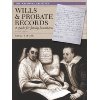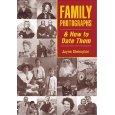

|
|
Family History Information
This section could be sub-titled 'what information can you get for nothing?'
The most obvious starting point is the material - documents, certificates, pictures, letters and any biographical information - held by the family. Add to this the oral history one can access: the memories and stories in the minds of relatives. It may be possible to start building quite a detailed tree with attendant notes on character, occupation, and so on.
Oral History
Many older people will be happy to yarn extensively about their relatives from the past. For example, in the author's case, 'interviewing' a great-aunt, it was possible to rekindle a memeory of the aunt's own grandmother describing a great-grandparent born over 150 years ago. Note-taking or even recording their reminiscences could be a rich source of information at a later date. Such memories are likely to be unformed, perhaps rambling, and may not make much sense as one hears it but at a future time when more structured information is available, the oral accounts may give you useful insights and hints about new directions worth investigating.
It would be unfair to give family members the 'third degree' but a few interviewing tips and tricks would not go amiss. Questions beginning with Who? What? Why? When? Where? will help flesh out information and provide useful new avenues to follow.
There are pitfalls to this. No-one has perfect memory: sometimes names can be confused or forgotten; stories can be attached to the wrong person; periods of time may be shortened or lengthened; whole sequences or individuals can be obliterated. People have likes and dislikes, exaggerating the characteristics of a person from the past and up- or down-grading them in their importance and influence on events - the proverbial 'black sheep' associated entirely with negatives and others painted as saints or angels. Often memories come from childhood: a child's perspective is entirely different from that of an adult. Actions and events may be misunderstood or interpreted in the wrong way.
Where possible get two or more opinions on the same event or person. If this is not achievable, or even if it is, look to see if dates, events, etc. can be confirmed by documentary evidence. Think of any detail, oral or written as a piece of jigsaw - the apparently mundane can be the key to unlocking a story. The difference between this kind of jigsaw and its cardboard equivalent is that a piece not only fills a gap but also changes a part, or all, of the picture.
Written material
The existence of written material is very much a matter of luck. The writer's great-grandfather kept annual diaries throughout most of his life, according to surviving relatives. They were not the equivalent of Samuel Pepys' diary, or even those of modern politicians more concerned about self-promoting memoirs than in detailed facts. No, they were the commercial appointment-type diaries used for recording doctors/dentists visits and other trivia, along with the occasional sentence or two of commentary. But they would have told us a great deal about the daily pattern of his life. And although born some 140 years ago, he had a few adventures, including trips to Scandinavia and the Mediterranean.
The same relatives recount how all those diaries, together with an unknown quantity of personal records and ephemera were neatly piled in the back garden and burned! All except a single diary kept because it recored details of a property dispute. Fortunately that diary included a reference to attending a sister's funeral in an unexpected place.
Written materials may be retained in some families with more appreciation and respect for them as pieces of family history. The author's wife was fortunate to receive a small parcel of letters written to a cousin in the 1920's and 1930's. These had been kept by the cousin and her son and were then forwarded to a descendant of the writer by his bereaved wife in the early 2000's. They contained references to relatives, to a family wedding, to their jobs, fashions, foods, and visits to Portsmouth dockyard. These were all references in ordinary letters between ordinary people that enriched our knowledge of their lives, proved relationships and provided unthought of opportunities to follow up more family connections.
Another type of communication that can be a rich source of information, albeit fragmentary, is the family postcard. Many people retain postcards for years, and collecting them has always been popular. First developed at the end of the 19th century, they became the e-mails or text messages of their day. Postal collections and deliveries in the pre-telephone age were sufficiently frequent to allow a card to be sent and a reply received on the same day. If you are fortunate enough to have access to a good collection of family cards you may be able to follow a 'conversation' about an interesting event in your family history.
Other forms of ephemera include receipts and invoices, birthday and anniversary cards, wedding invitations, and lists, funeral service programmes and newspaper cuttings. We will consider newspaper records more fully later. Other, more formal documents such as certificates, wills, property records and inventories will also be discussed in later sections.
Family Bibles
Family bibles can be productive sources of genealogical information. Large family bibles were commercially produced in the early 20th century with pages laid out for the recording of births, deaths, marriages and, particularly after the First World War, military service and wartime deaths.
Photograph Albums
Photograph albums were first compiled in the second half of the 19th century but often the photos were untitled. Many of us have albums or boxes of anonymous individuals who will remain unidentified.
Previous page: Your Family History.
Next page: Memorials.
 Wills and Probate Records: A Guide for Family Historians  Tracing Your Ancestors from 1066 to 1837  The Genealogist's Internet: The Essential Guide to Researching Your Family History Online  Family Photographs 1860-1945 (Public Record Office Genealogist's Guides)  Family Photographs and How to Date Them  Writing Your Family History: A Practical Guide |
Copyright © 2009-2025 Alan Price and IslandGuide.co.uk contributors. All rights reserved. Island Guide makes minimal use of cookies, including some placed to facilitate features such as Google Search. By continuing to use the site you are agreeing to the use of cookies. Learn more here